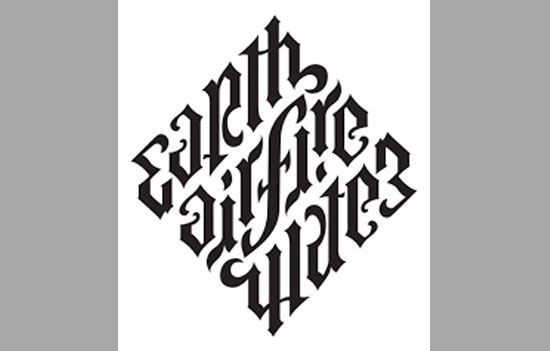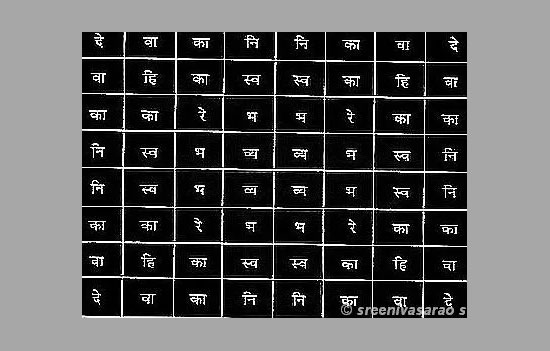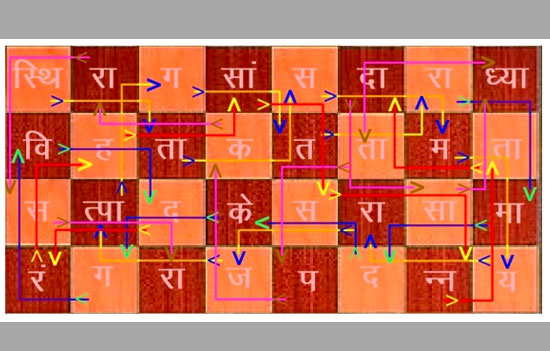- What is Chitrabandha? What do they convey? Sri Vedanta Desika provided the solution to the knight’s tour problem 600 years ago, much before Swiss Mathematician Leonhard Euler (1707-1783).
Many of us would be familiar with
this ambigram from the popular fiction, Angels and Demons by Dan Brown.

Why is it that we experience a
comparable pleasure when we have understood the meaning behind an abstract
structure?
Citrabandha, is a wonderful class of
poetry, based in brilliant flexible or rather mischievous play of vowels,
consonants, words and sounds.
The elements of the verse are, at
times, picturesquely patterned into designs (bandha), geometric figures or into images of familiar things in
life such as a flower, wheel, flag, drum, umbrella, mace etc. Perhaps because
of its figurative quality this class of poetry is known as citra-kavya.
The term citra is interpreted to
mean an image as well as a unique method of conveying the meaning (vicitra artha) that evokes wonder. It
aims to generate a sense of awe by innovative poetic structures, designs or
patterns (bandha) resembling objects (vastu)
or movements (gati) of animals and
birds or at times even objects that one commonly sees in life. The other way to
look at it is to treat citra-kavya as architecture of poetry where the sounds
of syllables (matra) and letters (aksara) take a visible form.
According to Indian tradition, the
relationship between speech (vac) and
meaning (artha) is invariably
connected, thereby leading to an equation of the two with the primordial
parents of the universe, Parvati-Parameshvara, as found in the invocatory verse
of Raghuvamsa of kalidasa. The word
is that which when articulated gives out meaning; and meaning is what a word
gives us to understand. The tradition, therefore, believes that Kavya is a
unity or composition (sahitya) of word (sabdalankara) and its meaning
(arthalankara).
Citra-kavya embraces all
ingenious forms of poetic compositions-the skillful artistry of words
and clever arrangement of letters, different combination of words, variations
in meanings when the sequence of words when read from the reverse direction and
so on.
The object of Citra-kavya is to
ignite awe and wonder; to evoke amusement and pleasure; and, to offer
intellectual challenge. These techniques also
contributed to cryptography and espionage wherein Kuta artha or meanings hidden under the surface of connotative reading was employed. In Mahabharata there are verses that play on alliterations, puns and chimes, and in the Jatugrha episode, we come across Vidura’s warning to Yudhishthira about the lac-palace, expressed in a form of a Kutashloka.
In Bharavi’s great work the Kiratarjuniya, skanda scolds the retreating gaṇa-s thus:
देवाकानिनि कावादे वाहिकास्वस्वकाहि वा ।
काकारेभभरे काका निस्वभव्यव्यभस्वनि ॥
devakanini kavade vahikasvasvakahi va
.
kakarebhabhare kaka nisvabhavyavyabhasvani. KA 15.25
It has two aspects to it: one is the
set of constraints (bandha-s) pertaining its symmetry, which can be pictorially
depicted (citra) as what may be termed a Sarvatobhadra
Maṇḍala:
दे वा का नि नि का वा दे वा हि का स्व स्व का हि वा ।
का का रे भ भ रे का का नि स्व भ व्य व्य भ स्व नि ॥

It shows the symmetry of the square
to both reflection and rotation-hence the term sarvatobhadra. Hence, the
commentator Mallinatha Suri from the Vijayanagara court of Devaraya
states:
चतुष्कोष्ठे चतुरङ्ग बन्ध क्रमेण आद्य पङ्क्ति चतुष्टये पाद-चतुष्टयं विलिख्यन् अन्तर्-पङ्क्ति-चतुष्टयेऽप्यधःक्रमेण पाद-चतुष्टय-लेखने प्रथमासु चतसृषु पङ्क्तिषु प्रथमः पादः सर्वतो वाच्यते, द्वितीयादिषु द्वितीय इत्यादि |
The second aspect to such bandha-s
is that with such constraints, the entropy of the text reduces, i.e. it becomes
low in complexity. Thus, the problem arises as to how a more complex meaning
can be extracted from it.
Thus, for our low-complexity
sarvatobhadra verse we need the meta-knowledge of the kavya-specialists to
decode meaning from it. From commentators Allinatha and Ratneshvara we
get:
devakanin = deva + a-kayati (derived from the
root kai meaning noise/sound): possessed of the shouts of the deva-s or devakanin = deva a-kan: inciting the deva-s; devakanini = masculine locative case.
ka-vade = confused cries; locative,
hence: wherein there are confused shouts or kavade = ka (head) + ava-a-da (cut down): wherein heads are cut down.
vahika=movement of army or van of the
army,
svasvakahi= sva (one’s own) + svaka (own party) + a-hi (from root hi meaning to bear forward): bearing forward one’s own party or su (good) + asvaka (not one’s own property, i.e. of the enemy) + a-hi: hastening with good property of the enemy
va= and indeed
kakarebhabhare (again a locative) = ka (water, i.e., rut secretion) + a-kṛi(from root kṛi as in kiryate – to pour out) + ibha (elephant) bhara (weight or temporal globe of elephants): where musth pours from the elephant’s temple or ka (splendor) + a-kṛi (from root kṛi as in kiryate – to scatter, e.g., prakirṇa) + ibha (elephant) bhara (multitude): where the splendor of the elephant multitude is scattered.
kakaḥ (in vocative) = a contemptible one or greedy for plunder
nisva= ni-sva: selfless or with no
worth
bhavya = worthy or successful result
vya= concealing or the vya= squander
bhasvan = revealed or bhasvan-
reviling.
Thus, we can have forward and
backward interpretations:
Wherein (in the battle) there are shouts of the deva-s, wherein heads are cut down, wherein the movement of the army bears forward one's own party, wherein the splendor of the elephant multitude is scattered, O contemptible ones (i.e., the retreating gaṇas)! Therein they revile those who squander the selfless and a successful outcome.
Wherein the worthy and the worthless under concealment are revealed, wherein the elephant’s temporal globe flows with rut, O ones greedy [for plunder], wherein the van of the army hastens with the wealth of the enemy, therein the deva-s are incited [to war] in the midst of confused cries.
One might ask at this juncture – are these really the meanings which Bharavi originally intended for the verse? With Mallinatha, Ratneshvara and our own meditation we get different meanings from the verse – so is it not so very subjective, with so many unusual words and constructs?
Regarding the first question it is
clear that Bharavi composed the verse with the symmetry of a square, the sarvatobhadra, so that meanings might be extracted forwards and backwards and they reveal themselves only after careful study if one were to allow for the least violence to grammar. This is not at all something which can be achieved easily – hence, it is a high art form.
Indeed, king Bhoja-deva commenting
on the structural feats of sarga 15 of the kiratarjuniya regards it as the
ornament of the whole work. The origins of such structural poetry might be
traced back to recombination of meters performed with the vaidika mantra-s during the shrauta
rituals.
Regarding the so-called subjectivity the shruti holds: “parokṣha-priya iva hi deva
bhavanti pratyakṣha-dviṣaḥ. (Gopatha Brahmaṇa of the Atharvaveda 1.2.21)”
Thus, it is in the nature of a kavi to utilize such modes of expression which have the capacity to encode various alternative meanings, via the “epigenetic code” of parokṣha.
Amongst the several unique bandhas
that have been employed, one example would suffice to understand the complexity
and the excellence of this style of composition, the turaga-bandha.
Turaga-bandha and The Knight’s walk
The Turagabandha mimics the moves of the knight on the Chess board. It
is considered to be terse and is the most celebrated of all the bandhas.
There is a mathematical problem known as the knight’s tour problem which involved the moves of the knight pawn on an empty Chess board. The knight would have to move so that it visits every square (64) on the board only once, and, at the end of the tour, must come back to the square from which it began.
Sri Vedanta Desika, the remarkable
scholar whose glorious contribution to Indian Knowledge Systems fetched him the
title Sarvatantrasvatantra, in his
poetic composition, Paduka Sahasram celebrating the glory of Sri Ranganatha’s padukas in 1008 verses, employs citra-bandha 40 verses. (composed in a single night).
Among these, the verse No.929 and No.930 are hailed as an astounding solution to the ‘knight’s tour problem’.
The syllables of the first Sloka
(No.929) are posted, in sequence, on the squares of the Chess board.

स्थिरागसां सदाराध्या विहताकततामता । सत्पादुके सरसा मा रङ्गराजपदं नय ॥
O the sacred Padukas of the Supreme!
You are eulogised by the men who have committed unpardonable sins; yet you
remove their sins and all that is sorrowful and unwanted; you create a musical
sound. Lead me to the feet of Lord Ranganatha.
Then sequentially arranging the
syllables on the squares that the knight visits we get the 930th
verse-
स्थिता समयराजपत्पा गतरामादके गवि ।
दुरंहसां सन्नतादा साध्या तापकरासरा
You remain in an effulgent position
with Devi Lakshmi, being benevolent to the worshippers. You ward away the
misery of the sinners. When the Lord wishes to venture out, you make his
walk enjoyable. May you kindly lead me to the divine abode of Lord
Ranganatha!
It is believed that the first mathematician to investigate the Knight’s tour problem was a Swiss mathematician, Leonhard Euler (1707 to 1783) and since then it has come to be known as Euler Chess Knight Problem. But Sri Desika not only provided the solution to the knight’s tour problem six hundred years ago but went far beyond that.
In conclusion, Shri Kalanath Jha in his scholarly treatise ‘Figurative Poetry in Sanskrit Literature’ states that-
“Citrakavya which entertains and challenges, far from being ‘inferior’, demonstrates the amazing possibility inherent in a language, along with the potential for originality and creativity. The excellence achieved in Citrakavya is unmatched in any of the literature in the world over. Backed by a history of more than a thousand years, Citrakavya still continues to be composed by small pockets of scholars throughout India. Yet, sadly, it seems to be a dying art.”
Also read Modern
English Chitrakavya by Prof. Donald Knuth (2005)-Similar to Harivijaya - Chitrakavyas
on IIT Bombay site with pictures
Read by author Kashi
Tamil Sangam
Author Dr Ketu Ramachandrasekhar is the Program Manager at Bharatiya Samskriti Trust, a Non-Profitable Organisation dedicated towards the dissemination of Indic Knowledge Systems and resurgence of the Oldest Living Cultural way of life i.e. Sanatana Dharma. He has his Doctorate in Indian Epistemology and was selected as a Fellow from hundred young scholars across India for Studies in Neuro Aesthetics and Indian Rhetoric by Ministry of Culture, GOI. He was a part of Academic Team of scholars across Europe on discussion of Natya Texts. His expertise in Shaiva Pratyabhijna School is well recognised by scholars of Kashmir Shaivism and he has been a regular contributor to their Journals on the works and contributions of Acharya Abhinavagupta. He has several research articles and books to his credit which includes a detailed study of Abhinayadarpana of Nandikeshvara, Devi Mahatmya and others. His advice is also sought in matters relating to prayoga aspect of Tantra Shastra by established centers of Shakti worship like Kollur and Kanchipuram.